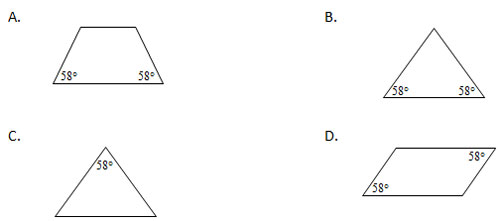
Jamail wants to paint a wall in his bedroom. Describe how he can calculate the area that he will be painting if there are two windows in the wall that he wants to paint.

A. Multiply the height of the wall by the width of the wall.
Incorrect. He does not want to paint the windows also.
B. Add the areas of the windows to the area of the wall.
Incorrect. The windows take away from the wall area, not add to it.
C. Subtract the areas of the windows from the area of the wall.
Correct! Since the windows will not be painted, their area has to be subtracted from the area of the wall.
D. Find the combined areas of the two windows.
Incorrect. This is how much of the wall he will NOT be painting.
You have called your friend who is a math genius so that she can help you work a geometry problem. You tell her the problem is about an isosceles triangle with base angles of 58 degrees. Which diagram shows what your friend would have drawn based on your description?

A
Incorrect. This is a trapezoid, not a triangle.
B
Correct! This is an isosceles triangle with base angles of 58 degrees.
C
Incorrect. This labels the vertex angle as 58 degrees.
D
Incorrect. This is a parallelogram, not a triangle.
Mason was told to give an example of two lines that were perpendicular. He chose to use a coordinate graph for his example. Which graph shows a pair of perpendicular lines?

A
Incorrect. Check that the slopes are opposite signed reciprocals of each other.
B
Incorrect. These lines are parallel.
C
Correct! The slopes are opposite signed reciprocals of each other.
D
Incorrect. Check that the slopes are opposite signed reciprocals of each other.
A watering trough has parallel sides and semicircular ends as shown.

Which of the following can be used to determine how much water the trough will hold?
A. V = 2 (π × 12 + 2 × 4)
Correct! This is the correct formula for the figure with a rectangular base 4 ft long and radii of the semicircles are 1 ft.
B. V = 2 (π × 12 + 2 × 6)
Incorrect. The rectangular part of base is 4 ft long.
C. V = 2 (2 × 6)
Incorrect. The rectangular part of base is 4 ft long.
D. V = 2 (π × 22 + 2 × 4)
Incorrect. The radii of the semicircles are 1 ft.